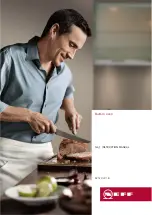
15
Baking
In this section, you will find information on
■
Baking tins and trays
■
Baking on two or more levels
■
Baking basic doughs and cake mixtures (baking table)
■
Baking pre-prepared frozen products and freshly prepared
meals (baking table)
■
Tips and tricks for baking
Note:
Do not use shelf height 2 when baking with
3
CircoTherm®. The air circulation would be impaired and this
will have a negative effect on your baking.
Baking in tins and on trays
Baking tins
We recommend that you use dark baking tins made from metal.
Tinplate and glass dishes increase the baking time required
and the cake will not brown evenly. If you wish to bake using
tinplate tins and
%
Top/bottom heat, you should use shelf
height 1.
If you wish to use silicone baking tins, use the information and
recipes provided by the manufacturer as a guide. Silicone
baking tins are often smaller than normal tins. The amount of
mixture and recipe instructions may differ.
If you are baking on one level with
3
CircoTherm®, always
place a loaf tin diagonally (Fig. A) and a round tin in the centre
of the stepped wire rack (Fig. B).
Baking trays
We recommend that you only use original baking trays, as
these have been optimally designed for the cooking
compartment and the operating modes.
Always slide the baking tray or the universal pan in carefully as
far as it will go and make sure that the sloping edge is facing
the appliance door.
Use the universal pan if you are baking moist cakes, so that the
cooking compartment does not get dirty.
Baking on two or more levels
If you are baking on several levels, you should preferably use
baking trays and insert these at the same time.
Bear in mind that your items may brown at different rates on
each level. The items on the top level will brown more quickly
and can be taken out earlier.
If you wish to bake on two levels using a baking tray and a
universal pan, you should insert the baking tray at shelf
height 3 and the universal pan at shelf height 1.
Baking table for basic doughs/cake mixtures
The values in the table are guidelines and apply to enamelled
baking trays and dark baking tins. The values may vary
depending on the type and amount of dough/mixture and on
the baking tin.
We recommend that you set the lower of the specified
temperatures the first time. Lower temperatures will generally
allow more even browning.
If you are baking according to your own recipe, use similar
recipes in the table as a guide.
Observe the notes in the table about preheating.
$
%
CircoTherm®
3
Top/bottom heat
%
Basic dough
Shelf
height
Tempera-
ture in °C
Baking time in
minutes
Shelf
height
Tempera-
ture in °C
Rich sponge mixture
Tray bakes with topping
1
160 - 170
30 - 45
3
170 - 180
1 + 3
150 - 160
40 - 50
-
-
Springform cake tin/loaf tin
1
150 - 160
60 - 80
2
160 - 170
Flan tin
1
160 - 170
20 - 35
2
170 - 180
Shortcrust pastry
Tray bake with dry topping, e.g. crumble
1
160 - 170
45 - 70
3
180 - 190
1 + 3
160 - 170
60 - 80
-
-
Tray bake with moist topping, e.g. egg custard
1
150 - 170
60 - 80
-
-
Springform cake tin, e.g. sponge base cheesecake
1
150 - 160
50 - 90
2
160 - 180
Flan tin
1
150 - 160*
20 - 35
2
170 - 180*
Sponge mixture
Swiss roll
1
180 - 190*
10 - 15
3
190 - 200*
Flan tin
1
160 - 170
20 - 30
2
160 - 170
Sponge (6 eggs)
1
150 - 160
30 - 45
2
160 - 170
Sponge (3 eggs)
1
150 - 160*
20 - 30
2
160 - 170*
* Preheat oven
















































